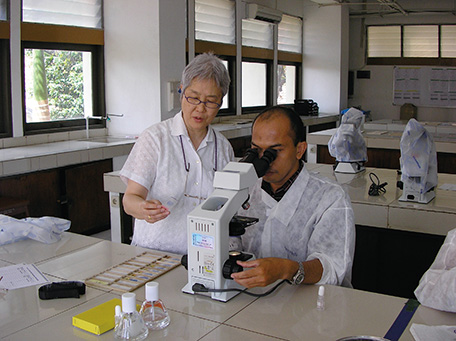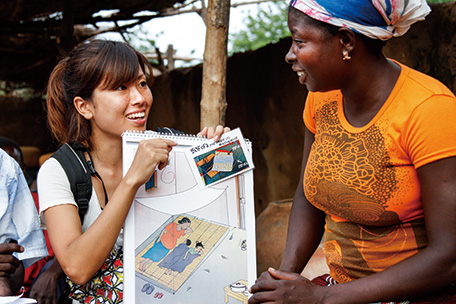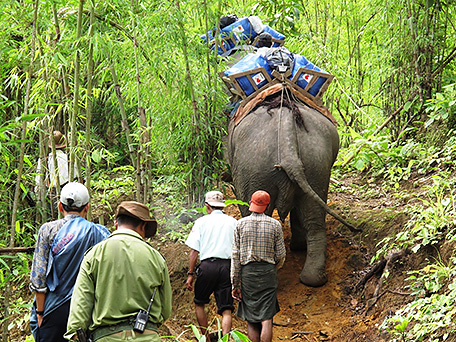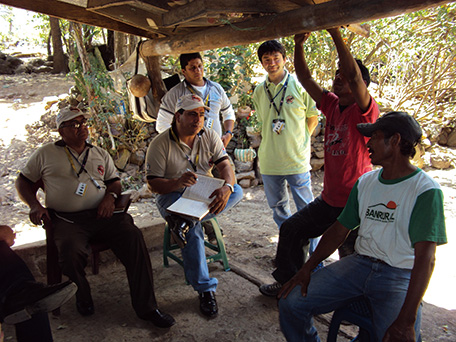Japan's Official Development Assistance White Paper 2012
(2) Infectious Diseases
Infectious diseases such as HIV/AIDS, tuberculosis, and malaria are a major problem that affects not only the health of individuals, but also the socio-economic development of developing countries. In addition, co-infection of HIV/AIDS and tuberculosis, and the emergence of multidrug-resistant and extensively drug-resistant tuberculosis for which conventional drugs are not effective is a significant problem. Further, strengthening measures against new strains of influenza, tuberculosis, malaria, and other emerging and reemerging infectious diseases*, as well as ramping up for the final stage of initiatives to eradicate polio, continue to be international issues.
Moreover, "neglected tropical diseases"* such as Chagas disease, Filariasis, Schistosomiasis have infected approximately 1 billion people worldwide(Note 10), causing major socio-economic loss in developing countries. Because infectious diseases have an impact that crosses national borders, the international community must unite to address them. Japan cooperates closely with the relevant countries and international organizations to implement countermeasures.
<Japan's Efforts>
●The three major infectious diseases (HIV/AIDS, tuberculosis, and malaria)
Japan attaches great importance to supporting the fight against these diseases through "the Global Fund to Fight AIDS, Tuberculosis and Malaria (the Global Fund)." Discussions on measures against infectious diseases held for the first time at the G8 Kyushu-Okinawa Summit held in 2000 led to the establishment of the Global Fund as an organization to provide funding against the three major infectious diseases. As one of its founders, Japan has contributed to the Global Fund since its establishment in 2002. At the MDGs Summit in September 2010, Japan pledged to contribute up to $800 million to the Global Fund in following years. It then reaffirmed its pledge at the World Economic Forum in Davos, Switzerland in 2012 at the milestone 10th anniversary of the Global Fund. Japan has contributed approximately $1.6 billion to the Global Fund through July 2012. It is estimated that this support has saved more than 6.5 million lives. Additionally, Japan is ready to provide supplemental bilateral aid to developing countries receiving aid from the Global Fund so that measures against these three major infectious diseases can be implemented effectively in those countries. Japan is also striving to strengthen the linkage between the aid from the Global Fund and the improvement of health care systems and the policies for maternal and child health in those countries.
As HIV/AIDS countermeasures through bilateral aid, to prevent new infections Japan spreads knowledge, raises awareness, provides testing and counseling, and enhances the distribution of drugs to treat HIV/AIDS. In particular, mainly in Africa, JOCV on HIV/AIDS Control are vigorously engaged in the spread of knowledge and understanding of prevention, and in the care and support of people living with HIV/AIDS.
About tuberculosis, under the Global Plan to Stop TB 2006-2015, Japan has been promoting the implementation of a series of measures against tuberculosis such as the prevention of infection, early detection, diagnosis, and continuous treatment to the countries prioritizing the prevention of tuberculosis that the World Health Organization (WHO) has designated and the countries with high prevalence of tuberculosis, and also the measures against co-infection of HIV/AIDS and tuberculosis. In July 2008, the Ministry of Foreign Affairs (MOFA) and the Ministry of Health, Labor and Welfare (MHLW) announced the "Stop TB Japan Action Plan" that was developed jointly with JICA, the Japan Anti-Tuberculosis Association, and the Stop TB Partnership Japan. Japan would utilize the experience and technology it had fostered through domestic tuberculosis countermeasures domestically, and in collaboration between the public and private sectors, has worked to reduce the number of deaths from tuberculosis by 10% (160,000 people, based on 2006 figures) worldwide, by focusing efforts on reducing such deaths in developing countries, particularly in Asia and Africa. The group revised the Stop TB Japan Action Plan in 2011 in response to WHO's 2010 revision of the original plan into Global Plan to Stop TB 2011-2015. They confirmed that they would continue to fight tuberculosis on a global level under new international health policies.
Japan assists in efforts to implement measures against malaria, a major cause of infant mortality, by strengthening local communities and through cooperation with the United Nations Children's Fund (UNICEF).

A mosquito net soaked in insecticide is an effective way to prevent malaria. Nigeriens set up a provided mosquito net. (Photo: JICA)
Note 10: Source: "10 facts on neglected tropical diseases" http://www.who.int/features/factfiles/neglected_tropical_diseases/en/index.html![]()
![]() (WHO)
(WHO)
●Polio
Polio is in the final stages of eradication. Japan works mainly with UNICEF to support planning and other efforts to eradicate polio chiefly in three polio-endemic countries (countries in which polio was never eradicated and is still spreading), namely Nigeria, Afghanistan and Pakistan. In August 2011, Japan partnered with the private sector's Gates Foundation through nearly ¥5 billion of ODA loan for providing polio vaccinations to about 32 million Pakistani children under age five. Further, Japan worked with the Gates Foundation, etc. in October 2011 to host a World Polio Day event in Tokyo.
●Neglected tropical diseases
In 1991, Japan took the lead and launched a full-scale effort against Chagas disease, which is known as a "disease of poverty", in Central America. Japan helped establish a system for dealing with Chagas disease vectors and continues to help reduce the risk of infection. In regard to Filariasis, Japan supplies antiparasitic agents as well as educational materials to provide knowledge and understanding to a large number of people. Japan also conducts preventive education through JOCV in order to reduce the number of new patients and maintain the non-epidemic status.
●Vaccinations
It has been proven that vaccinations are an inexpensive and effective method of combating infectious diseases, and it is estimated that 2 to 3 million lives could be saved each year with vaccination.(Note 11) In 2011, Japan made its first contribution of $9.3 million to the Global Alliance for Vaccines and Immunization (GAVI)*, which was established in 2000 to improve the vaccination rate in developing countries. It has been estimated that assistance through GAVI had saved 5.91 million lives by 2011, and that it would be able to save 4 million more lives by 2015, the deadline for achievement of the MDGs.

A Japanese expert leads a local staff member in sputum smear testing. (Photo: JICA)

JOCV sometimes goes on door-to-door visits to educate the public about using and repairing mosquito nets to prevent malaria in Brukina Faso. (Photo: Akio Iizuka/JICA)
- *Emerging/reemerging infectious diseases
- Emerging diseases: SARS (severe acute respiratory syndrome), avian influenza, the Ebola virus, and other infectious diseases that were not known in the past but that have been newly recognized in recent years.
Reemerging diseases: Cholera, tuberculosis, and other infectious diseases that had spread widely in the past, then subsequently saw a decrease in the number of patients and were believed to have converged, but that have increased again in recent years. - *Neglected tropical diseases
- Chagas disease, dengue fever, filariasis, and other diseases transmitted from parasited, bacteria, etc. The number of infected individuals has reached approximately 1 billion worldwide, with some cases resulting in death, although many of the diseases could be prevented or eradicated. In addition, because of factors such as the prevalence among the poor, there is little public concern, so the development and spread of diagnostic methods, treatment, and new drugs is lagging.
- *Global Alliance for Vaccines and Immunization (GAVI)
- A public-private partnership that aims to increase access to immunizations in 57 developing countries (as of July 2012). GAVI consists of the governments of member countries and relevant international organizations with cooperation from the pharmaceutical industry, private foundations and NGOs.
Note 11: Source: "Health Topics Immunization" http://www.who.int/topics/immunization/en![]()
![]() (WHO)
(WHO)
●Myanmar
Major Infectious Disease Control Project
Technical Cooperation Project (January 2005 - January 2012; March 2012 - Present)
Malaria and tuberculosis are the top two causes of death in Myanmar in that order, and HIV/AIDS has infected over 330,000 people there. Myanmar urgently needs to develop measures against these three infectious diseases. This project has been contributing to preventing the spread of these diseases in Myanmar by helping build the capacity of personnel at medical and government institutions. For tuberculosis, the project supports diagnoses and treatments of tuberculosis patients, offering guidance to laboratory technicians, participatory health education programs for citizens and enhanced connections for private hospitals, pharmacies and communities. For malaria, the project contributes to community-based anti-malaria measures (early diagnosis and treatment), containing malaria that has developed resistance to major malaria medicines, distributing bed nets and diagnostic kits and improving access to malaria medicines. For HIV/AIDS, the project offers technical guidance for blood testing, education for blood donors and others and support for improving the ability to detect other sexually transmitted diseases and to manage and analyze data.
Myanmar became unable to efficiently provide malaria medicines after support from the Global Fund to Fight AIDS, Tuberculosis and Malaria (Global Fund) was suspended in 2005 (support resumed in 2011). To counter this, Japan has cooperated with the Global Fund by incorporating knowledge and experience gained through the aforementioned project and a management system for smooth distribution of malaria medicines into the Global Fund activities. Partnering with the Global Fund in this way should provide Myanmar with better measures against infectious diseases.
(As of December 2012)

Mosquito nets to prevent malaria are delivered to remote areas by an elephant. (Photo: JICA)
●Nicaragua
Strengthening of Activities of Survey and Control for Chagas Disease
Technical Cooperation Project (September 2009 - Present)
Chagas disease is a parasitic disease found mainly in Central and South America. It is transmitted to humans through blood-sucking shield bugs known as assassin bugs, blood transfusion or from infected mothers to their newborns during pregnancy or childbirth. There is no way to treat the disease once it has progressed, and some people even die of heart disease or other maladies 10 to 20 years after becoming infected. An estimated 7.5 million people have been infected with Chagas disease throughout Central and South America, and it is estimated that at least 50,000 of the 5.87 million people in Nicaragua have become infected. Assassin bugs prefer to live in houses with mud walls and straw roofs, and many people prone to infection are poor people who live in such houses.
Japan uses knowledge and experience gained in Guatemala, Honduras and other Central American countries in this project to persistently control vector infection in five departments in Northern Nicaragua. It has been offering supports focused on enhancing four areas of capacities : (1) study capacity for understanding the habitats of assassin bugs (blood testing/entomological surveys); (2) operational capacity for spraying insecticides to prevent assassin bugs from reproducing inside houses; (3) operational capacity for a Chagas disease monitoring system in which residents work together with the government by reporting discoveries of assassin bugs to health care centers; and (4) residents’ capacity to prevent Chagas disease through technical guidance and awareness raising campaigns seeking to improve living and sanitary conditions to eliminate environments inside and outside houses in which assassin bugs lie dormant.
(As of December 2012)

Members discussing measures against Chagas disease. (Photo: JICA)
